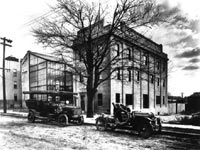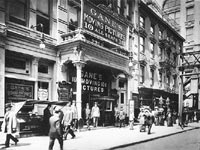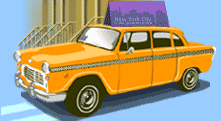 |
|
 |
 |
 |
 |
 |
 |
 |
 |
 |
| The Edison motion-picture studio in the Bronx, 1913 |
 |
It's Friday night at the movies. What's playing? How about "A Train Pulling Out of the Station" or "Traffic at the Local Intersection"? Rather stay home? Not New York's first film audiences.
For them, moving pictures -- invented in the late 1800s -- seemed like magic. You could see things happening that had actually happened somewhere else. Ordinary scenes, when captured on film, were entertainment enough, at least at first.
 |
 |
| A moving-pictures theater in 1910 |
 |
Soon big moving picture cameras could be seen in the stations of the number 1 subway line, on a traffic island on Lower Broadway, and atop the city's first skyscrapers. New York audiences flocked to see the 10-minute movies of everyday life, paying five cents at storefront theaters called nickelodeons. By the early 1900s, New York had dozens of these theaters. Most had little more than a projector, a screen, some camp chairs, and a piano.
Of course, the newness of everyday films was bound to wear off. Soon people wanted longer movies with stories. The first was the "Passion Play," a biblical story shot on a New York rooftop in 1897.
Audiences also wanted more comfortable places to watch the longer movies. The city's first real movie theater -- the 1,800-seat Regency -- opened in 1913. Within a few years, New York was home to dozens of movie palaces, showcase theaters designed to look like exotic Egypt, India, China, and Spain. In them, audiences of thousands watched movies and also vaudeville shows, comedians, and even orchestras.
 Top illustration: Courtesy of the U.S. Department of the Interior, National Park Service, Edison National Historic Site.
Top illustration: Courtesy of the U.S. Department of the Interior, National Park Service, Edison National Historic Site.
Illustration at bottom: Courtesy of Steeplechase Films.
|
 |
 |
 |
 |
 |
 |
 |
 |
 |
|
 |
 |








